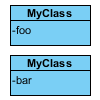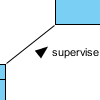When your project is simple, you are able to express all of the design ideas with just a few diagrams. The diagrams are simple and self-explanatory. Each of them represents a distinct design idea and there is no overlapping between diagrams.
When you are dealing with a complex project, you may need to draw multiple diagrams to represent different contexts. You need to borrow shapes from a diagram to make them appear in other diagrams (i.e. contexts). In fact, this is extremely common when modeling with class diagram and business process diagram. Take UML class diagram as an example, there may be a domain diagram that presents all the entity classes and, another diagram that presents the associations and dependencies between a specific controller class and its related entity classes. So in this case, both diagrams contain the same set of entity classes.
Instead of re-creating those classes again and again in different diagrams, Visual Paradigm allows you to “re-use” them. Through simple copy and paste (Ctrl-C and Ctrl-V), you can easily copy a shape from one diagram to another. Each shape is formally known as a “view”. So with this, you can create multiple views for a model element in representing different contexts. Changes made on a shape are all synchronized to other instances that appear in other diagrams without extra effort. This is great, but there is a drawback though.
Read more
 Users are not allowed to give same name to two different UML classes when the classes are put under the same parent. It is like you cannot have two physical files with same name in same directory, or having two Java classes with same name under same package.
Users are not allowed to give same name to two different UML classes when the classes are put under the same parent. It is like you cannot have two physical files with same name in same directory, or having two Java classes with same name under same package.
 In UML (Unified Modeling Language), an association can be used to represent that two classifiers which are related with each other. On any binary association, you may optionally put a solid triangular arrowhead near the name of the association to define the way the association should be read. In this article, we will see how to show the triangular arrowhead on an association in
In UML (Unified Modeling Language), an association can be used to represent that two classifiers which are related with each other. On any binary association, you may optionally put a solid triangular arrowhead near the name of the association to define the way the association should be read. In this article, we will see how to show the triangular arrowhead on an association in  Programming languages like C or C++ accepts nameless arguments in function declaration. You may write something like void myFunction(double){…} to declare a function that accepts a double as argument. In modeling level, you can represent this kind of function by not showing the parameter name in an operation. This article shows you how to do this.
Programming languages like C or C++ accepts nameless arguments in function declaration. You may write something like void myFunction(double){…} to declare a function that accepts a double as argument. In modeling level, you can represent this kind of function by not showing the parameter name in an operation. This article shows you how to do this.